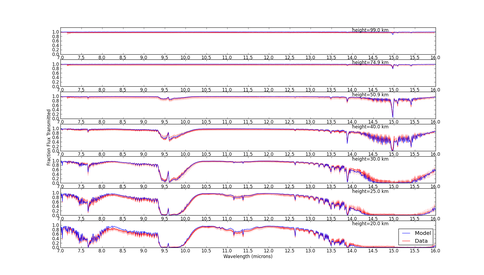2012 Annual Science Report
 VPL at University of Washington
Reporting | SEP 2011 – AUG 2012
VPL at University of Washington
Reporting | SEP 2011 – AUG 2012
Earth as an Extrasolar Planet
Project Summary
Earth is the only known planet that can support life on its surface, and often serves as the typical example of what a habitable planet looks like. In anticipation of future discoveries of observable, potentially habitable worlds around other stars, this task seeks to understand how we would characterize and understand the distant Earth. To accomplish this, we have developed several tools and approaches for simulating and investigating the Pale Blue Dot. In particular, we have demonstrated how an airless moon can affect observations of a habitable planet, developed new metrics to measure atmospheric pressure, and modeled light reflected off liquid water surfaces.
Project Progress
We have made significant advances over the reporting period in developing and applying tools to both simulate and interpret observations of Earth and Earth-like planets.
The Virtual Planetary Laboratory (VPL) 3-D spectral Earth model, which simulates the time-dependent disk-integrated spectrum of our planet from any arbitrary viewing geometry, has been used in a number of investigations. In Robinson (2011), this model was paired with a model of the phase-dependent thermal infrared (IR) spectrum of the Moon to explore (1) how airless satellites influence the IR spectrum of their host, and (2) a technique for detecting exomoons using spatially-unresolved IR spectra. Such studies are important, as moons will not be spatially resolved from their host planet by next-generation exoplanet characterization missions. Spectra from the VPL 3-D spectral Earth model are also being used in our “Observer” task, where we are simulating the appearance of Earth to future observational facilities (e.g., the Terrestrial Planet Finder – Coronagraph) using instrument simulators.
In anticipation of facilities that are capable of acquiring transit transmission observations of Earth-like planets (e.g., NASA’s James Webb Space Telescope), we have developed an add-on to the VPL’s line-by-line, multiple scattering radiative transfer tool – the Spectral Mapping Atmospheric Radiative Transfer (SMART) model. The transmission spectroscopy model has been applied to Earth, permitting validation against (1) ATMOS (Atmospheric Trace Molecule Spectroscopy Experiment) observations of the Earth’s limb from the near-IR through the thermal-IR, and (2) lunar eclipse spectra of the Earth’s transmission spectrum in the visible and near infrared. We are currently applying the model to Earth-like exoplanets to explore how oxygen dimer features in the visible and near-iR may allow us to measure surface pressure on Earth-like exoplanets, which is an important aspect of determining habitability (Misra et al. 2012).
In continuing work on directly detecting surface liquid water, we have further developed, and presented results from, a model that simulates the orbital variations in brightness and polarization of light scattered by Earth-like planets (Zugger et al. 2011a,b). In this work, we showed that polarization could provide important additional information for detecting a water ocean on an Earth-like planet using glint from the water surface.
Finally, we have been building tools to interpret spectral observations of Earth-like planets. In Schwieterman et al. (2012), we introduced a technique for using disk-integrated near-IR spectra to retrieve certain bulk planetary properties, including the surface temperature, which is a crucial determinant of habitability. The technique has been validated against the VPL 3-D spectral Earth model, and against observations of Earth and Mars from NASA’s EPOXI mission. In the future, such an approach may allow us to determine whether a world is a partially-clouded, ocean-bearing planet like Earth, or a dry world with heterogeneous mineralogy like Mars.
A comparison between observations (red) and the VPL/SMART transit transmission model (blue) of the transparency of Earth’s atmosphere as seen in a transit-like configuration. Observations are from the Atmospheric Trace Molecular Spectroscopy (ATMOS) experiment, which recorded the transmission of Earth’s atmosphere by taking space-based observations of the Sun as it was occulted by the atmosphere. The wavelength range is through the mid-infrared, and the different sub-figures are for different tangent heights through the atmosphere for the line connecting the observer to the Sun.
Publications
-
Robinson, T. D. (2011). MODELING THE INFRARED SPECTRUM OF THE EARTH-MOON SYSTEM: IMPLICATIONS FOR THE DETECTION AND CHARACTERIZATION OF EARTHLIKE EXTRASOLAR PLANETS AND THEIR MOONLIKE COMPANIONS. The Astrophysical Journal, 741(1), 51. doi:10.1088/0004-637x/741/1/51
-
Zugger, M. E., Kasting, J. F., Williams, D. M., Kane, T. J., & Philbrick, C. R. (2011). SEARCHING FOR WATER EARTHS IN THE NEAR-INFRARED. The Astrophysical Journal, 739(1), 12. doi:10.1088/0004-637x/739/1/12
- Meadows, V. & Robinson, T. (2011). Astrobiology from Earth-Sun L1. AGU Fall Meeting Abstracts.
- Misra, A.K., Meadows, V.S., Claire, M. & Crisp, D. (2012). Measuring Atmospheric Pressure on Earth-like Exoplanets. Astrobiology Science Conference.
- Robinson, T. & Meadows, V. (2011). Once in a Pale Blue Dot: Simulated Observations of an Extrasolar Earth-Moon System. AGU Fall Meeting Abstracts.
- Schwieterman, E., Robinson, T.D., Meadows, V.S., Deming, D., A’Hearn, M., Charbonneau, D., Hewagama, T., Lisse, C., Livengood, T.A., McFadden, L., Seager, S. & Wellnitz, D. (2012). Characterizing Terrestrial Exoplanets: Evaluating Temperature and Albedo Retrieval Methods with Near-IR EPOXI Earth and Mars Spectra. Astrobiology Science Conference.
- Zugger, M., Kasting, J., Williams, D., Kane, T. & Philbrick, C. (2011). Brightness and Polarization of Extrasolar Planet Oceans and Atmospheres. AGU Fall Meeting Abstracts.
-
PROJECT INVESTIGATORS:
-
PROJECT MEMBERS:
David Crisp
Co-Investigator
Mike Zugger
Postdoc
Amit Misra
Graduate Student
Edward Schwieterman
Graduate Student
Jonathan Breiner
Undergraduate Student
Nicole Evans
Undergraduate Student
-
RELATED OBJECTIVES:
Objective 1.2
Indirect and direct astronomical observations of extrasolar habitable planets.
Objective 7.1
Biosignatures to be sought in Solar System materials
Objective 7.2
Biosignatures to be sought in nearby planetary systems


